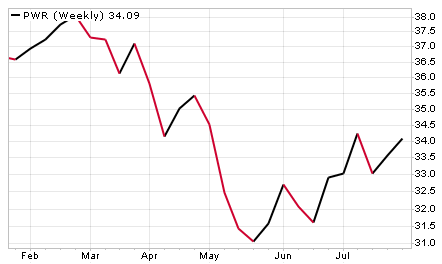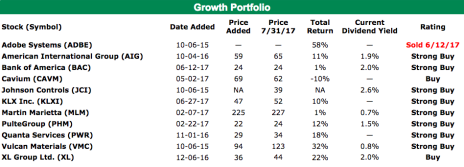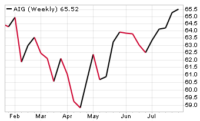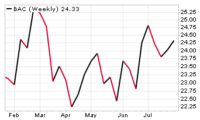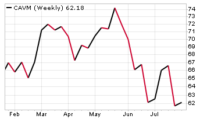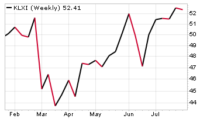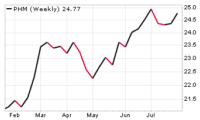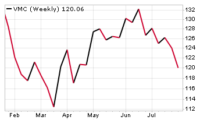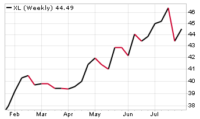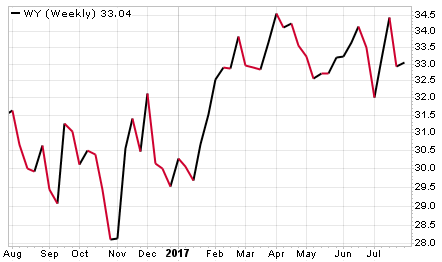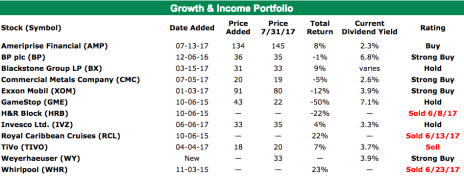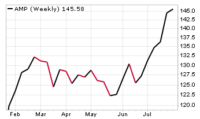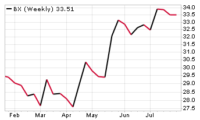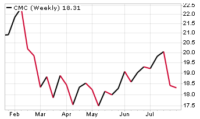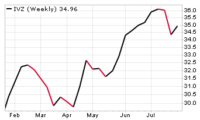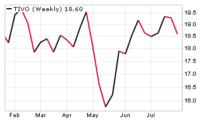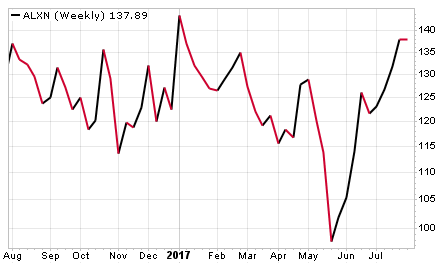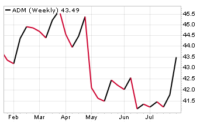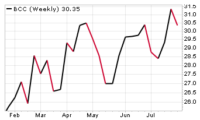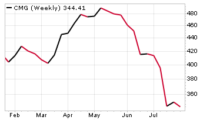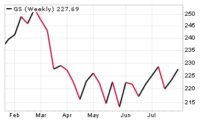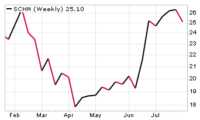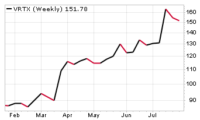We have two new additions to the portfolios in today’s issue, one of our stocks has changed its name, and one stock is now rated Sell.
Cabot Undervalued Stocks Advisor 817
[premium_html_toc post_id="136922"]
Who’s Right About the Stock Market This Year, Bulls or Bears?
Investors often ask me whether I foresee a stock market correction or crash looming in the coming months. Indeed, I’m asked that question on radio shows several times each month. Let’s visit that topic today.
Historically, the S&P 500 index rises 20% or more, two to four times each decade. You can get a good visual of the performance history on this bar chart published by Macrotrends. Notice that during the current decade, we’ve only experienced one 20%+ year in the S&P 500. That was in 2013. That’s great news, which tells you that we are far more overdue for a big year in the stock market than we are overdue for a down year. Newscasters don’t tell you that, do they? That’s because good news doesn’t keep viewers glued to their news programs. But you all know I’m no fan of news media, so I’ll step off that soapbox now.
More good news … well, sort of. Regular investors—neighbors, coworkers, relatives—are not heavily invested in the stock market. I could look up all kinds of statistics on that, but anecdotal evidence has always been enough for me to take the market’s temperature.
I remember 1987, when my coworkers were excitedly buying stocks that were touted by their friends. I remember the tech stock boom, when investors begged me for every tech stock IPO issued by Morgan Stanley, where I got to play Santa Claus with very limited amounts of IPO shares. And I remember the real estate frenzy about 10 years ago, when all anybody wanted to talk about was their house-flipping. Each of those three frenzied buying scenarios was followed by a crash in their respective markets.
Rule of thumb: when the average investor is excitedly talking about a particular investment at church, at the grocery store, and in the DMV line, that’s when you know that investors are “all in.” Once they’re all invested, there’s no more money available to drive that particular market up. And that’s when prices start falling.
Do you recently hear much excitement about stock investing from the people you run into in your day-to-day life? I do not. I’m far more likely to run into people who think I’m nuts for being bullish!
Here’s what I think will happen next. The S&P 500 is up 10.4% year-to-date at 2,472. That’s 10%. You think I’m kidding, right? Based on the way everybody’s acting like a market crash is going to happen next week, you’d assume that the market had risen about 83% so far this year! Nah … it’s just getting started.
We’re going to have a 20%+ year, because the market does that every couple of years, and we’re due. Of course, it helps that there’s no dearth of companies with strong earnings growth to buy right now. Sure, Amazon (AMZN) has an overvalued P/E, but I can offer you fifty undervalued growth stocks today. I can’t recall any major stock market corrections coming about during time periods when there were so many attractive stocks to choose from.
My advice is this: relax about the market. Buy undervalued stocks. Sell overvalued stocks, in order to minimize your portfolio risk. Keep about 15% to 20% of your portfolio in cash, so that you can take advantage of price pullbacks that arise.
I plan on making more money this year. The one thing I won’t be doing is turning on the television. Send questions and comments to crista@cabotwealth.com.
Portfolio Notes
Make sure to review the Special Bulletins from July 25, July 26 and July 27 in which I mentioned news, rating changes and/or price action on Ameriprise Financial (AMP), Boise Cascade (BCC), Chipotle Mexican Grill (CMG), Commercial Metals (CMC), Invesco (IVZ), Johnson Controls (JCI), Legg Mason (LM), PulteGroup (PHM), Quanta Services (PWR), Schnitzer Steel (SCHN), Total (TOT), Universal Electronics (UEIC), Vertex Pharmaceuticals (VRTX) and XL Group (XL).
Buy-Rated Stocks Most Likely To Rise More Than 5% Near-Term:
BP plc (BP)
Boise Cascade (BCC)
Dollar Tree (DLTR)
KLX (KLXI)
Martin Marietta Materials (MLM)
Quanta Services (PWR)
Total (TOT)
Today’s Portfolio Changes:
Alexion Pharmaceuticals (ALXN) joins the Buy Low Opportunities Portfolio with a Buy recommendation.
Tesoro (TSO) changed its name to Andeavor (ANDV).
TiVo (TIVO) moves from Hold to Sell.
Weyerhaeuser (WY) joins the Growth & Income Portfolio with a Strong Buy recommendation.
Last Week’s Portfolio Changes:
Goldman Sachs (GS) moved from Hold to Buy.
Schnitzer Steel (SCHN) moved from Buy to Hold.
Universal Electronics (UEIC) moved from Buy to Hold.
Calendar of upcoming quarterly earnings reports:
August 1 am: Archer Daniels Midland (ADM), BP plc (BP) and Martin Marietta Materials (MLM)
August 2 am: Vulcan Materials (VMC)
August 2 am: American International Group (AIG) and Cavium (CAVM)
August 3 am: Quanta Services (PWR)
August 3 pm: TiVo (TIVO) and Universal Electronics (UEIC)
Thus far this earnings season through July 31, 15 of our portfolio companies reported June quarter results. Among those 15 companies, 10 reported EPS that exceeded analysts’ consensus estimates—five of which exceeded all analysts’ estimates, one came in on target, and four fell short of consensus estimates.
Growth Portfolio
Growth Portfolio stocks have bullish charts, strong projected earnings growth, little or no dividends, low-to-moderate P/Es (price/earnings ratios) and low-to-moderate debt levels.
Featured Stock: Quanta Services (PWR)
Quanta Services provides specialized infrastructure and network services to the electric power, oil and natural gas industries. Its geographic areas of operation focus on the U.S., Canada and Australia. The company is based in Houston, Texas, with 24,500 employees.
The corporate outlook remains fantastic. Revenue growth is coming from all segments of the company, notably from acquisitions, electric power projects and a continued recovery in the natural gas industry. Quanta is benefiting from ongoing upgrades to an aging electrical grid and has a project backlog totaling over $9 billion. In May, CEO Duke Austin remarked, “Our end markets are strengthening and we believe there is opportunity for our backlog to achieve record levels over the coming quarters.”
Quanta completed the acquisition of energy services companies Stronghold, Ltd. and Stronghold Specialty, Ltd. on July 21. Quanta is paying $450 million in cash and stock for the companies. The transaction is expected to be accretive to Quanta’s 2017 net income, to the tune of about $0.06 to $0.07 non-GAAP EPS. The Stronghold businesses have been producing about $500 million in annual revenue, which will now contribute to Quanta’s oil & gas infrastructure services business.
The company will report second-quarter results on the morning of August 3. The market is expecting $0.53 EPS, with a range of $0.48 to $0.61. PWR had a volatile day last week when Baird lowered the stock to a Hold, but by day’s end, the price completely recovered, then finished out the week as if the downgrade hadn’t occurred. That price action bodes well for the stock’s potential reaction to this week’s earnings report. I would imagine that if second-quarter results come in on target or better, investors will respond by pushing the share price up, since they clearly showed no interest in the Baird analyst’s Eeyore prognostications.
Wall Street expects steady revenue growth from $7.7 billion in 2016 to $8.4 billion in 2018 and $9.1 billion in 2018. Consensus full-year earnings estimates rose in late July, now reflecting aggressive EPS growth rates of 32.5% and 20% in 2017 and 2018. The corresponding P/Es are low in comparison at 16.8 and 14.0.
The stock does not pay a dividend. The long-term debt-to-capitalization ratio has been extremely low for many years, and currently stands at 9.6%.
Quanta’s common stock share count is interesting if you’re a numbers person who studies stocks. The number of basic outstanding common shares peaked in 2014 at 219.67 million, then declined 11.2% in 2015, and another 19.4% in 2016 to 157.29 million. It’s highly unusual to find companies with such aggressive share repurchases. In May 2017, Quanta authorized a new $300MM share repurchase plan. That could reduce the share count by about 5.6%, or 8.8 million shares.
Quanta’s common stock is 83%-owned by financial institutions.
This industrial stock does not have a glamorous story. It’s simply a very undervalued aggressive growth stock. PWR doubled in price from early 2016 through February 2017, and therefore needed to rest and digest its huge run-up. After pulling back in the springtime, PWR bottomed in late May, then began ratcheting upward. I expect the stock to rest again when it retraces its February high at 38.5. Once the stock breaks past 38.5, there’s no upside resistance that could put a ceiling on the share price.
Not only is the stock attractive from a capital gain point of view, but if I were a bigger company looking to buy a profitable mid-cap company that could enhance my bottom line, I’d consider an M&A transaction. Buy PWR now. Strong Buy.
Updates on Growth Portfolio Stocks
American International Group (AIG – yield 1.9%) is a diversified insurance company. AIG will report second-quarter results on the afternoon of August 2. The consensus earnings per share estimate is $1.20, with a range of $1.10 to $1.33. The stock meets all of my growth & value criteria. AIG is rising toward its January high near 67. I wouldn’t be surprised to see the stock continue climbing shortly thereafter. Strong Buy.
Bank of America (BAC – yield 2.0%) Consensus EPS estimates have risen to reflect 17.4% and 19.8% growth in 2017 and 2018, with corresponding P/Es of 13.2 and 11.0. The new $0.12 quarterly payout per share that investors will receive in late September has not yet been officially declared, and therefore it’s not reflected when you pull up stock quotes on brokerage firm websites or NASDAQ.com. The official declaration will take place near August 1. BAC is an undervalued large-cap growth stock. BAC has short-term upside price resistance at 25.5, which it could easily surpass this year. Strong Buy.
Cavium (CAVM) is a very undervalued, aggressive growth semiconductor stock. A Jefferies analyst expects Cavium’s new server chip product to steal market share from Intel. Cavium will report second-quarter results on the afternoon of August 2. The consensus earnings per share estimate is $0.65, within a range of 64 to 66 cents—unchanged in recent weeks. A good earnings report could push the share price to 67 or higher.
CAVM fell last week, retracing its lows from early July. The consensus full-year earnings estimate has remained unchanged for three months. I mention that because some investors are invariably wondering whether a big change in the earnings outlook might have caused the share price to fall recently. But the culprit seems to be a focused pessimism surrounding Cavium’s QLogic fibre channel business that ignores new product momentum and gains in wireless infrastructure market share. Buy.
Johnson Controls (JCI – yield 2.6%) is an undervalued, multi-industry growth stock. The company reported third-quarter revenue and profit on target last week, while slightly lowering its full-year EPS expectation (September year-end). In an overreaction to the company’s full-year guidance, the market pummeled the stock, knocking it down 10% after the earnings release. Importantly, consensus full-year EPS estimates have only changed by a penny, give or take, during the last four months. Analysts expect EPS to grow 14.2% in 2018 (September year-end), with a P/E of 12.8. Gabelli & Co. assessed the quarter and raised its rating to Buy based on undervaluation of the stock and underappreciation of the company’s outlook. The share price has not settled down yet, although it seems ready to bounce at price support that was established in 2016. Strong Buy.
KLX Inc. (KLXI) is a manufacturer of aerospace fasteners, consumables and logistics. The market expects EPS to grow 194% and 27.2% in fiscal 2018 and 2019 (January year-end), with corresponding P/Es of 16.7 and 13.1. This is a lesser-known mid-cap stocks (market cap under $3 billion). We could therefore see both enhanced volatility and M&A prospects. KLXI could begin reaching new highs immediately. Buy KLXI now. Strong Buy.
Martin Marietta Materials (MLM – yield 0.7%) is an aggressive growth stock that’s quite undervalued based on 2018 numbers. Martin Marietta will report second-quarter results on the morning of August 1. The quarter’s consensus earnings per share estimate declined last week to $2.36, with a range of $2.17 to $2.48. The stock is showing a willingness to rise near-term, and could surpass price resistance at 240 this year. Strong Buy.
PulteGroup (PHM – yield 1.5%) Housing economics indicate a bullish outlook for homebuilders. The June Architectural Billings Index (ABI), a leading indicator of construction activity, rose for the fifth month in a row, suggesting a strong housing market in the coming year. Pulte reported a huge second-quarter earnings beat last week. (See the July 25 Special Bulletin.) Full-year 2017 and 2018 earnings estimates have been slowly changing since early May, with EPS expected to grow 37.1 and 23.4%. The corresponding P/Es are 11.2 and 9.1.
PHM is a very undervalued aggressive growth stock. PHM broke out of a long-term trading range in July, then pulled back a little. The advance will likely begin quite soon. Buy PHM now. Strong Buy.
Vulcan Materials (VMC – yield 0.8%) is a supplier of construction aggregates, asphalt and concrete. The company will report second-quarter results on the morning of August 2. The market is expecting $1.20 EPS, within a range of $1.11 to $1.28. Full-year earnings estimates fluctuate slightly every week, now reflecting 40.2% and 35.2% growth in 2017 and 2018, with corresponding P/Es of 30.9 and 22.9. Stocks within Vulcan’s peer group traded sideways all year. VMC could retrace 135 this summer, then possibly head higher. Strong Buy.
XL Group (XL – yield 2.0%) reported a strong second-quarter earnings beat last week. (See the July 27 Special Bulletin.) Revised consensus estimates project EPS to grow 100% and 21.5% in 2017 and 2018, with corresponding P/Es of 13.3 and 11.0. XL Group is an insurer and reinsurer.
On July 20, I moved XL from Strong Buy to Buy, and recently pointed out that “a brief pullback could happen at any time.” The pullback arrived last week, with XL dropping down to short-term price support at 43. Use this as a buying opportunity. I expect a relatively quick rebound. Buy.
Growth & Income Portfolio
Growth & Income Portfolio stocks have bullish charts, good projected earnings growth, dividends of 1.5% and higher, low-to-moderate P/Es (price/earnings ratios), and low-to-moderate debt levels.
Featured Stock: Weyerhaeuser (WY - yield 3.85%)
Weyerhaeuser is one of the largest manufacturers of wood and cellulose fiber products, with 38 facilities across the U.S. The company owns or controls 13.1 million acres of U.S. timberland, and is additionally licensed to manage timberland in Canada. Weyerhaeuser completed the $8.4 billion acquisition of Plum Creek Timber Company in February 2016. Please note that the company operates as a real estate investment trust (REIT).
Housing economics indicate a bullish outlook for homebuilders and their suppliers. The June Architectural Billings Index (ABI), a leading indicator of construction activity, rose for the fifth month in a row, suggesting a strong housing market in the coming year. That strength is reflected in Weyerhaeuser’s earnings projections. Wall Street consensus estimates project EPS to grow aggressively at rates of 36% and 29.4% in 2017 and 2018 (December year-end). The corresponding P/Es are 32.2 and 24.9.
Weyerhaeuser has a $25 billion market cap. Financial institutions own 78% of the shares.
WY has been trading between 32 and 35 since February. I expect the stock to rise above its trading range in the coming months. The stock could appeal to aggressive growth investors and growth & income investors who should take advantage of the price while it’s low within that range. Traders should watch for a breakout above 34.5. Strong Buy.
Updates on Growth & Income Portfolio Stocks
Ameriprise Financial (AMP – yield 2.3%) offers insurance products and asset management to retail and institutional clients. Last week, Ameriprise reported second-quarter operating earnings that beat all analysts’ estimates, citing an increase in net annual revenue per financial advisor, and good performance in wealth and asset management. Higher catastrophe losses in its property & casualty insurance division were concerning. (See the July 26 Special Bulletin.) Full-year consensus earnings estimates jumped about 3.5%, now reflecting 33.1% and 10.6% EPS growth in 2017 and 2018. Corresponding P/Es are 12.8 and 11.6. AMP could easily trade anywhere between 135 and 160 in the coming months. Buy.
BP plc (BP – yield 6.8%) will report first-quarter results on the morning of August 1. The consensus earnings per share estimate is $0.18, within a range of $0.09 to $0.39. Full-year EPS are expected to grow 90.5% and 45.6% in 2017 and 2018, with corresponding P/Es of 22.0 and 15.1. The stock appears immediately ready to rise to 37, where it traded in May. BP could rise to a maximum of about 44 during the next year. Buy BP now. Strong Buy.
Blackstone Group LP (BX – variable large payouts) On July 26, Forbes published a long article recommending BX and other alternative asset managers. When BX reaches long-term price resistance at 38, I’ll remove the stock from the portfolio, rather than wait through a period of sideways trading. Dividend investors and long-term growth investors should feel comfortable keeping BX. Hold.
Commercial Metals Company (CMC – yield 2.6%) is a recycler and manufacturer of steel and metal products, including rebar and fence posts. Steel stocks fell last week as it became clear that a decision would be delayed with regard to the Commerce Department’s Section 232 investigation into trade cheating. In the coming months, I expect CMC to retrace its December 2016 high around 24. The current price drop represents a great buying opportunity. Strong Buy.
ExxonMobil (XOM – yield 3.9%) is the largest U.S. integrated oil company. ExxonMobil reported second-quarter earnings per share of $0.78 on July 28, when the market was expecting $0.84, within a range of $0.73 to $0.94. International upstream was weak, international downstream was strong, and capex was lower than expected. In the meantime, oil prices had their biggest weekly percentage rise this year. If that trend continues, it will be met with rising earnings estimates.
XOM is an undervalued growth stock. Shares of integrated oil companies have recently bounced at the bottoms of their 2017 trading ranges, with the bottom on XOM at 79 to 80. I encourage growth investors and dividend investors to buy XOM in anticipation of a maximum run-up to 91 this year, as it eventually retraces highs from July and December 2016. Strong Buy.
GameStop (GME – yield 7.1%) is a retailer of games, collectibles and technology, with additional ventures in the entertainment field. The company is transitioning through a multi-year process of diversifying its product areas away from a dependence upon physical game revenue. GME may be signaling a near-term run-up that could carry the stock to price resistance at 24.5. Hold.
Invesco (IVZ – yield 3.3%) reported a strong second-quarter revenue and EPS beat last week. (See the July 27 Special Bulletin.) However, outflows from equity mutual funds worried investors, causing the share price to fall about 7% on July 27. The second-quarter outflows were mostly caused by institutional investors who were invested in lower-margin products. On the bright side, July equity inflows were about $1.4 billion, completely changing the trend. Invesco is also actively expanding operating margins. Here’s a Barron’s article with buy recommendations from Wells Fargo and Jefferies analysts. In addition, my favorite Wall Street firm calls the price drop “overdone” and recommends that we “buy on weakness.”
IVZ is an undervalued growth & income stock in the asset management industry. I will very likely issue a sell recommendation as IVZ approaches upside price resistance at 38-39, where it last traded in March 2015. Traders who would be happy with a 10% return (plus dividend; ex-date August 15) should consider buying on dips below 35. Hold.
TiVo (TIVO – yield 3.7%) is a digital entertainment company that provides technology licensing and related services that enable people to access online and televised entertainment. The company will report second-quarter results on the afternoon of August 3. The quarter’s consensus EPS estimate is $0.26, within a range of 16 to 30 cents. TIVO is an extremely undervalued small-cap stock, expected to achieve 40%+ EPS growth in 2018.
The share price fell dramatically, three months ago, upon the release of a strong first-quarter earnings beat, apparently because TiVo has agreed with the Securities Exchange Commission not to report non-GAAP EPS in its earnings press releases. (I verified that fact with the company’s CFO.) News agencies that reported the quarterly results were incapable of calculating non-GAAP numbers, and therefore they reported at least five different inaccurate EPS numbers, four of which were below the real number, causing the share price to plummet. I’m not willing to potentially watch that situation unfold each quarter. I am therefore selling TIVO today, prior to the second-quarter earnings release. I still love the stock’s growth prospects, undervaluation and its appeal as a buyout target. However, my stock-investing strategy is designed around the goal of lowering the risk associated with stock investing. TiVo’s curious agreement not to report non-GAAP EPS numbers adds extra volatility to the share price. You might, as individual investors, be willing to accept that volatility, but I cannot knowingly inflict it upon new subscribers. Sell.
Buy Low Opportunities Portfolio
Buy Low Opportunities Portfolio stocks have neutral charts, strong projected earnings growth, low-to-moderate price/earnings ratios (P/Es) and low-to-moderate debt levels. (Dividends are not a portfolio requirement, but some of the stocks will have dividends.) Investors should be willing to wait patiently for these stocks to climb.
Sometimes a stock in the Buy Low Opportunities Portfolio produces good capital gains and the share price is no longer low, yet the stock remains an attractive investment. Those stocks will then be moved into the Growth Portfolio or the Growth & Income Portfolio.
Featured Stock: Alexion Pharmaceuticals (ALXN)
Alexion Pharmaceuticals (ALXN) is a biopharmaceutical company that researches and manufactures treatments of severe and rare health disorders. Its primary medical products are Soliris, Strensiq and Kanuma. The company is based in New Haven, Connecticut.
Alexion reported a strong second-quarter earnings and revenue beat last week. The company is aiming for double-digit revenue growth through 2019, along with expanding operating margins. A strong R&D pipeline contributes to potential investor enthusiasm for the company.
Full-year consensus earnings estimates have been rising in recent weeks, currently pointing toward EPS growth of 16.9% and 24.4% in 2017 and 2018 (December year-end). The corresponding P/Es are 25.6 and 20.5.
The company has not been repurchasing shares nor paying dividends. The long-term debt-to-capitalization ratio is relatively low at 24%, favoring Alexion’s penchant for acquisitions of companies, patents and assets.
ALXN is a large-cap stock with a $31 billion market capitalization. Financial institutions own 96% of the shares, and there are at least 19 analysts on Wall Street covering the company.
I was a big fan of ALXN when I first recommended the stock in December 2012, when profits were growing aggressively. I stopped recommending the stock in 2014 due to prospects of much slower EPS growth combined with a comparatively high P/E. But give a stock a little time to adjust to such changes, and you can oftentimes scoop up shares at a bargain price, as we’re doing today.
ALXN peaked at 204.3 in July 2015, then fell steadily to a low of 97.7 in May 2017, although it’s mostly traded between 110 and 140 during the last 14 months. I’ve been following ALXN all summer, and now that it appears immediately capable of breaking past 140, I’m adding it to the Buy Low Opportunities Portfolio.
Traders and growth investors should buy ALXN today. My intention is to hold the stock until it reaches upside price resistance at 160 or 190—depending on momentum among pharmaceutical stocks—providing a potential 15% or 37% capital gain.
Caveat: ALXN is receiving a Buy recommendation, rather than Strong Buy, because the stock is overvalued based on 2017 numbers. I reserve the Strong Buy recommendation for stocks that meet all of my EPS, P/E and debt criteria. Nevertheless, ALXN presents a great capital gain opportunity today. Buy.
Updates on Buy Low Opportunities Portfolio Stocks
Archer Daniels Midland (ADM – yield 3.0%) has a lower P/E than its eight biggest peers in the agriculture and fertilizer industry. Double-digit earnings growth is expected in 2017 and 2018. The company will report second-quarter results on the morning of August 1. The consensus earnings per share estimate is $0.52, within a range of 48 to 62 cents. ADM appears ready to break past 43 and head toward 47. Hold.
Boise Cascade (BCC) reported a second-quarter earnings miss last week, yet the market was pleased with the company’s outlook. (See the July 27 Special Bulletin.) Consensus estimates point to EPS growing 63.8% and 24.4% in 2017 and 2018, with corresponding P/Es of 18.2 and 14.6. BCC peaked above 33 on July 28, then came back down a bit. Buy BCC now for an immediate run-up. The stock could reach the upper 30s later this year. Strong Buy.
Chipotle Mexican Grill (CMG) reported a strong second-quarter earnings beat last week. (See the July 26 Special Bulletin.) Recent and consensus EPS are $0.77, $7.78 and $11.07 in the years 2016 through 2018. There’s no point in giving you an EPS growth rate for 2017 because the number would be 910%. Nice … except, meaningless. However, the 2018 EPS growth rate is 42.3% with a P/E of 31.7. Better! I can work with those numbers. Profits have rebounded with significant strength from 2016, which represented net income infected by e coli. Importantly, profits are expected to continue growing at a rapid pace. The stock remains undervalued.
I’m not moving CMG back to a Buy yet. Let’s give the share price some time to stabilize. Traders who want to take on the risk of buying now should later exit as CMG approaches 395. Hold.
Dollar Tree (DLTR) is experiencing 18.5% current-year earnings growth, higher than all of its discount retail and food company peers. Dollar Tree stores are outperforming the market’s expectations, while its wholly-owned Family Dollar stores are underperforming. Last week I wrote, “DLTR completed a double-bottom chart pattern in mid-July; a harbinger of immediate upside price action.” Sure enough, the stock rose right away. There’s about 15% upside as DLTR heads back toward 83, where it traded in May. Buy.
Goldman Sachs Group (GS – yield 1.3%) announced last week that they’ve teamed up with Fidelity Investments to offer loans of up to $25 million to the wealthy clients of independent investment advisors. GS is a fairly valued growth & income stock that will likely have a near-term run-up toward 250, at which point I plan to sell. Buy.
Legg Mason Inc. (LM – yield 2.8%) reported a huge first-quarter earnings beat last week (March year-end). (See the July 27 Special Bulletin, and this assessment from Barron’s.) Consensus estimates point toward 24.2% and 19.1% EPS growth in fiscal 2018 and 2019 (March year-end), with corresponding P/Es of 14.6 and 12.2. Legg Mason is an asset management and financial services company. I plan to sell as the stock approaches long-term upside price resistance at 44. Hold.
Mattel (MAT – yield 3.0%) reported a second-quarter loss per share of ($0.14) last week, when the market was expecting a loss in a range of ($0.03) to ($0.13) per share. (Toy companies generally produce seasonal profits in the third and fourth quarters.) Net international sales rose 8%, while North American sales lagged. (You will recall that the new CEO is focusing on future business in China.)
The stock is undervalued based on expected 2018 earnings growth of 23.4% and a 2018 P/E of 16.9 (December year-end). The strong 2018 earnings growth outlook should push MAT upward in the coming months. The share price recently bounced at a support level from 2015, and could reach a maximum of 23 this year before year-end tax-loss selling kicks in. Hold.
Schnitzer Steel Industries (SCHN – yield 2.8%) is one of the largest U.S. scrap metal recycling companies. SCHN is a small-cap stock in a volatile market sector, with relatively little analyst coverage. SCHN is resting after a huge run-up this summer. There’s upside price resistance at 27, and again at 29, where I plan to sell. Hold.
Andeavor (ANDV – yield 2.3%) changed its named from Tesoro Corp. (TSO) on August 1. Due to the increase in the share price combined with the decline in 2017 EPS estimates, ANDV is slightly overvalued based on 2017 numbers. However, the stock remains quite undervalued based on expectations for aggressive earnings growth in 2018. ANDV is up about 30% from its April lows, and still rising. There’s upside price resistance at 102, and again at 115, which represents long-term resistance from November 2015. Strong Buy.
Total (TOT – approx. 4.4%) reported second-quarter earnings that surpassed all analysts’ estimates last week. Full-year consensus earnings estimates were subsequently increased to reflect EPS growth of 14.5% and 15.2% in 2017 and 2018. The corresponding P/Es are 13.1 and 11.3. TOT is an integrated oil & gas company based in France, and a greatly undervalued growth & income stock. TOT could reach 54 in the short-term. My plan is to keep TOT in the portfolio until it reaches three-year price resistance in the low 60s. Strong Buy.
Universal Electronics (UEIC) will announce second-quarter results on the afternoon of August 3. The consensus earnings per share estimate is $0.78, within a range of $0.77 to $0.80. (There are very few analysts covering the stock.) Full-year earnings estimates have not changed since mid-May, with EPS growth of 15.1% and 20.0% expected in 2017 and 2018. The stock rose last week, and appears ready to continue ratcheting upward. I plan to sell near 79, where it last traded in August 2016. Hold.
Vertex Pharmaceuticals (VRTX) reported a strong second-quarter earnings beat last week. (See the July 27 Special Bulletin.) Vertex is an undervalued, aggressive growth biotech company that corners the market in treatments for cystic fibrosis (CF). The stock is declining a bit, which is a natural occurrence for any stock that just experienced a rapid run-up. I will likely recommend a Buy when the share price stabilizes. Hold.
[premium_html_footer]
Send questions or comments to crista@cabotwealth.com.
Cabot Undervalued Stocks Advisor • 176 North Street, Salem, MA 01970 • https://cabotwealth.com//
YOUR NEXT CABOT UNDERVALUED STOCKS ADVISOR ISSUE IS SCHEDULED FOR September 5, 2017
Cabot Undervalued Stocks Advisor is published by Cabot Wealth Network, an independent publisher of investment advice. Neither Cabot Wealth Network nor its employees are compensated in any way by the companies whose stocks we recommend. Sources of information are believed to be reliable, but they are in no way guaranteed to be complete or without error. Recommendations, opinions or suggestions are given with the understanding that subscribers acting on information assume all risks involved. Copyright © 2017 - COPYING AND/OR ELECTRONIC TRANSMISSION OF THIS NEWSLETTER IS A VIOLATION OF THE U.S. COPYRIGHT LAW. For the protection of our subscribers, if copyright laws are violated by any subscriber, the subscription will be terminated.
[/premium_html_footer]

